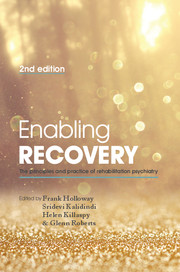Book contents
- Frontmatter
- Contents
- List of contributors
- List of figures, tables and boxes
- Preface
- Part 1 Setting the scene
- Part 2 Treatment approaches
- 7 Treatment approaches: overview
- 8 Rehabilitation at the coalface: practical approaches to helping people improve their functional skills
- 9 Cognitive approaches: cognitive–behavioural therapy and cognitive remediation therapy
- 10 Family interventions
- 11 Working with challenging behaviour
- 12 Working with coexisting substance misuse
- 13 Creative therapies and creativity
- 14 Management of medication when treatment is failing
- 15 Physical healthcare
- Part 3 Key elements of a rehabilitation service
- Part 4 Special topics in psychiatric rehabilitation
- Part 5 Future directions
- Index
11 - Working with challenging behaviour
from Part 2 - Treatment approaches
Published online by Cambridge University Press: 02 January 2018
- Frontmatter
- Contents
- List of contributors
- List of figures, tables and boxes
- Preface
- Part 1 Setting the scene
- Part 2 Treatment approaches
- 7 Treatment approaches: overview
- 8 Rehabilitation at the coalface: practical approaches to helping people improve their functional skills
- 9 Cognitive approaches: cognitive–behavioural therapy and cognitive remediation therapy
- 10 Family interventions
- 11 Working with challenging behaviour
- 12 Working with coexisting substance misuse
- 13 Creative therapies and creativity
- 14 Management of medication when treatment is failing
- 15 Physical healthcare
- Part 3 Key elements of a rehabilitation service
- Part 4 Special topics in psychiatric rehabilitation
- Part 5 Future directions
- Index
Summary
Introduction
‘Challenging behaviour’ is a phrase that has gained much currency within mental health services since it was first introduced in the 1980s. The initial usage of the term was confined to descriptions of problematic behaviour in younger individuals with intellectual disabilities but it has since been generalised to similar behaviours across the spectrum of psychiatric diagnoses and irrespective of age. Despite its acceptance in everyday psychiatric parlance, the precise meaning and definition of ‘challenging behaviour’ is often unclear and the phrase has been used as a substitute for a diagnosis or as a pejorative term to encompass those aspects of the behavioural manifestations of mental disorder that are less well understood and consequently difficult to manage.
It is likely that all clinicians working with behaviourally disordered patients will be familiar with the term ‘challenging behaviour’, and while most will have a notion of what they mean when using the phrase, a precise definition is hard to articulate. Emerson (1995) defined it as follows:
culturally abnormal behaviour of such an intensity, frequency or duration that the physical safety of the person or others is likely to be placed in serious jeopardy, or behaviour which is likely to seriously limit use of, or result in the person being denied access to, ordinary community facilities.
It is of significance that a diagnosis of a mental disorder or illness is not a prerequisite to classify an individual's behaviour as challenging if it meets the above broad criteria. It is therefore important for mental health practitioners to understand that challenging behaviour is not a diagnosis and can be observed in individuals with no mental disorder. It is most usefully conceptualised as a social construct that describes behaviours that fall well outside the usually accepted ideas of ‘normal’.
Types or categories of challenging behaviour
Classifying challenging behaviour allows clinicians and sometimes the patient to identify the processes involved in the expression and consequences of the behaviour. Challenging behaviours can be divided into those that are likely to cause harm to the person and those that might lead to harm to others. Each of these can be further subdivided into direct and indirect behaviours.
- Type
- Chapter
- Information
- Enabling Recovery , pp. 171 - 187Publisher: Royal College of PsychiatristsPrint publication year: 2015



